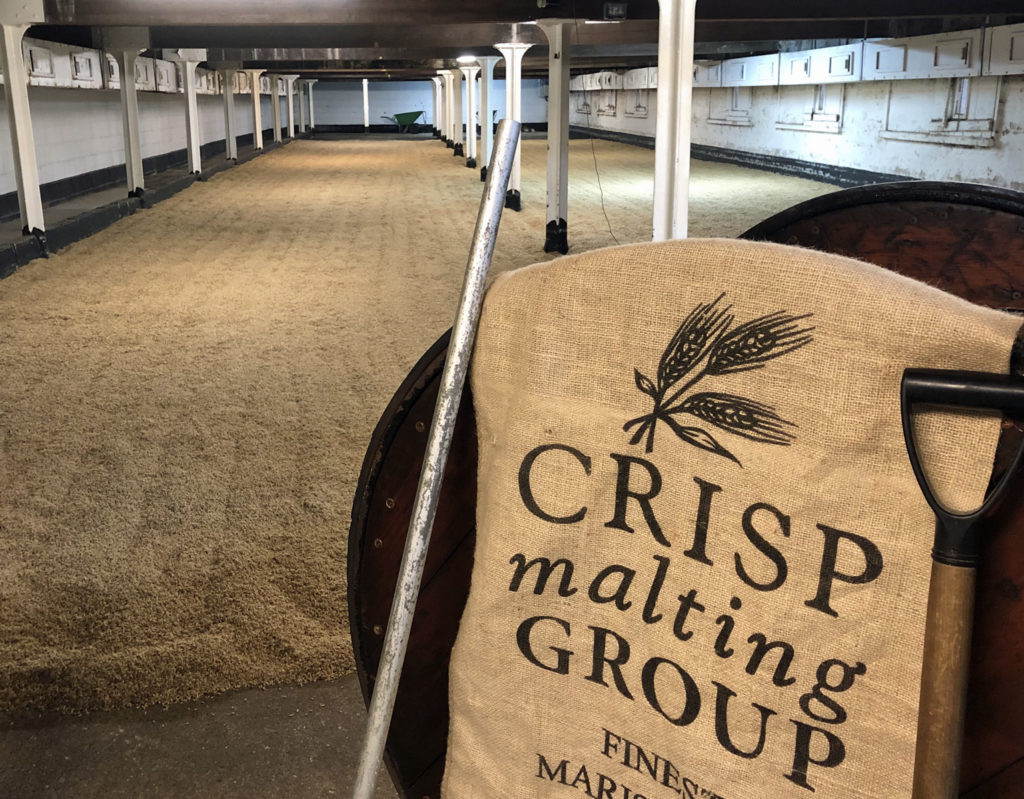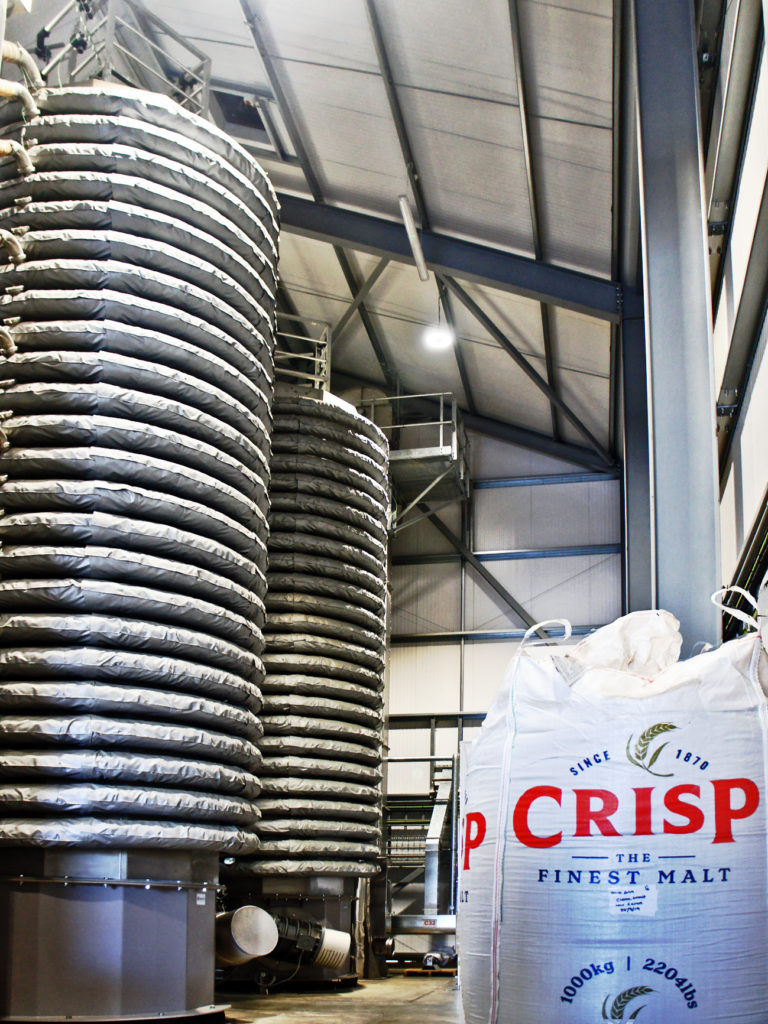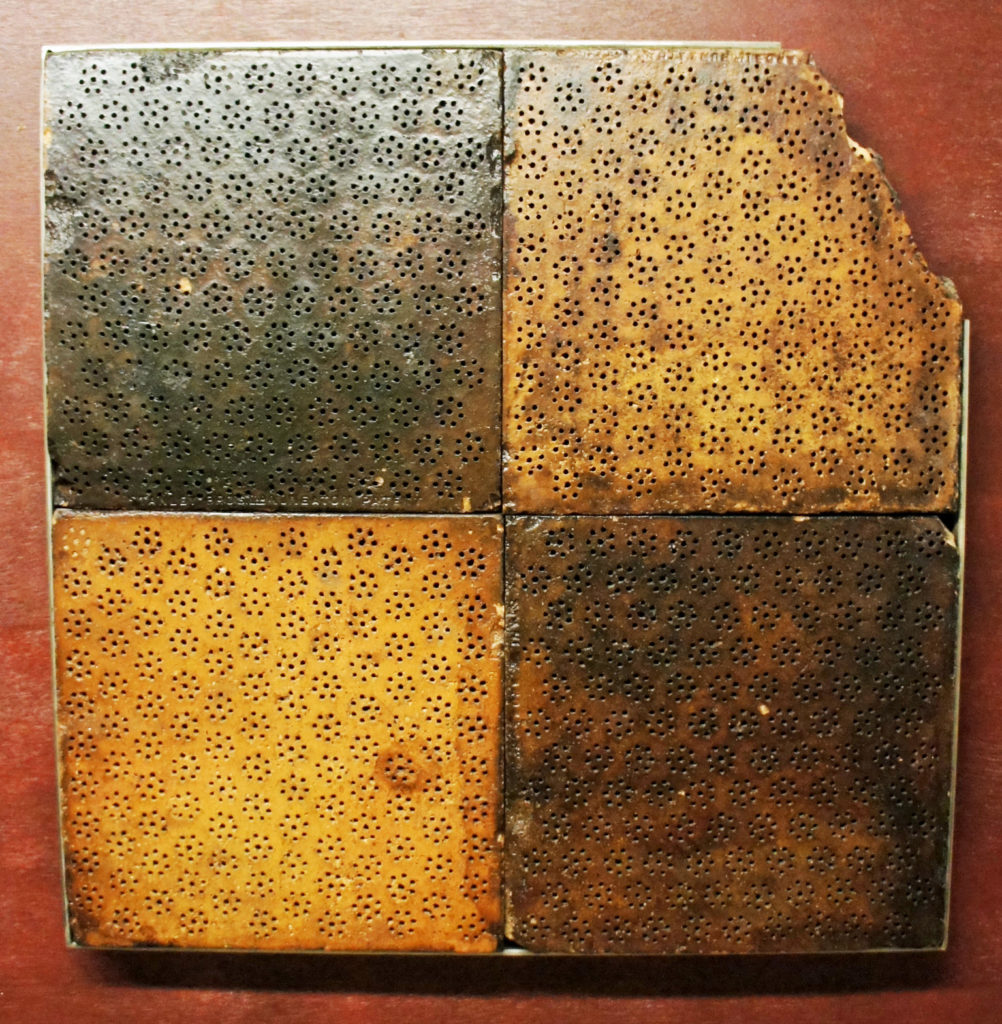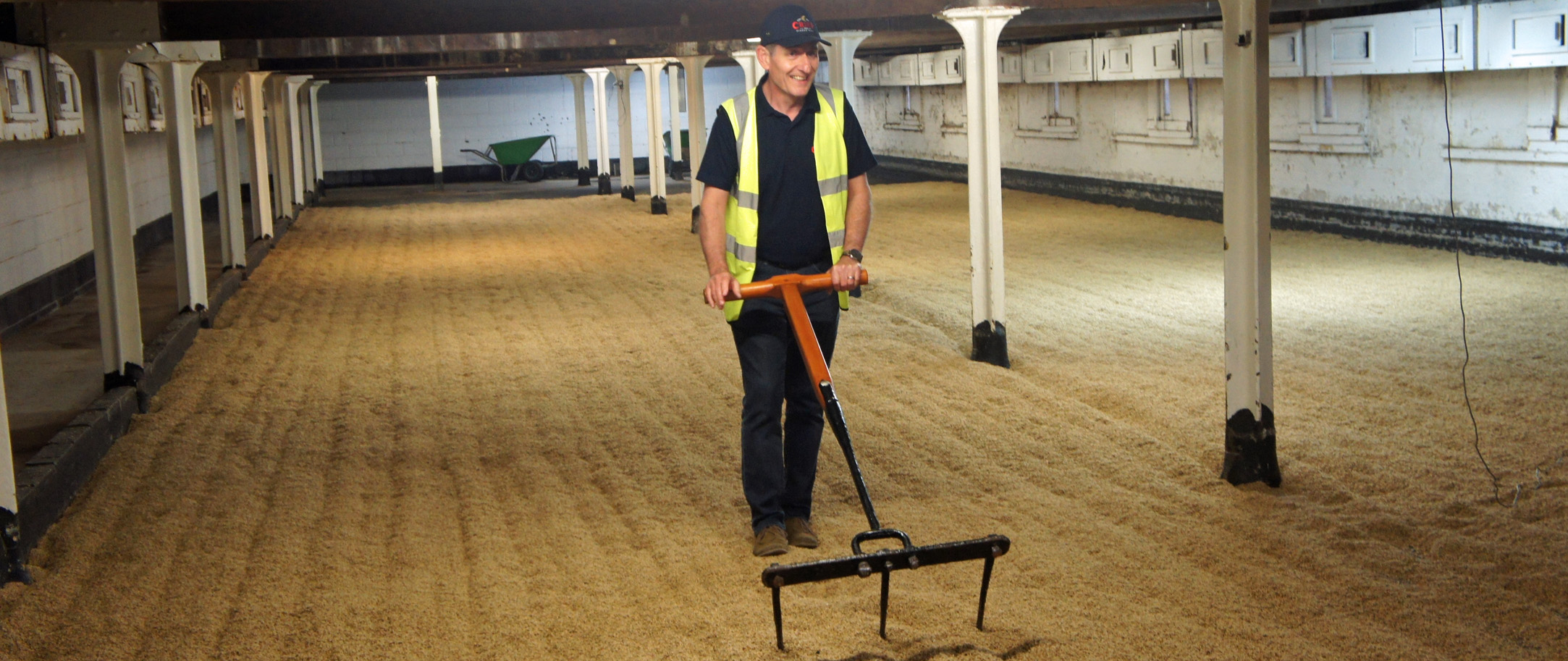That’s another one crossed off the bucket list … standing in a “live” floor maltings, watching the chemical magic that is barley enzymes turning starch into sugar in many millions of little seeds, all spread in a carpet four inches deep and probably 60 yards long and 15 yards wide. I grew up in Hertfordshire, where long, narrow maltings buildings can be found in most towns: there was one next door to my school, which had been acquired as overspill classrooms, so I can say I absorbed some of my education where malt was once made. I’ve been in plenty of disused floor maltings over the decades, in the UK and abroad, and I’ve seen a Saladin drum maltings in action, but never, until last Friday, a working floor maltings where malt is made in a way basically unchanged from the way it was made a thousand and more years ago.,

What I wasn’t expecting on the joint Brewery History Society/Guild of Beer Writers trip to Crisp’s maltings in Great Ryburgh in Norfolk was to be allowed inside the kiln, where the malt, once it has germinated enough, is dried off. These pyramidal structures, often topped with cowls that turn with the prevailing wind, are again familiar to anyone who has ever visited Ware in Hertfordshire, once the greatest malting town in the country, or Burton upon Trent, where multitudes of breweries had their own maltings. They are – or at least the one we were taken into – surprisingly spacious inside. Less surprisingly, it’s hot: but not that hot. To make properly dried pale malt takes about two and a quarter days of gentle heat. Too hot, to try to speed life up, and the malt will be too dark.

Next up, though, was a wonderful piece of 21st century malting kit just installed at Great Ryburgh, the Speciality Malt Plant, the only one of its kind in the UK, and so new its products are not even on sale yet: two 20-feet-high towers wrapped in spiral tubes that take raw malt and then toast, roast, stew or bake it to produce the complete range of coloured malts, from amber through brown and chocolate to black. The towers will also make crystal malts and other speciality malts, continuously, at a rate of 1.5 tonnes an hour, with the kind of control over the colour of the final product impossible using batch production methods.

Each tower has two off-balance electric motors attached that vibrate the assembly, shaking the grains of malt up the spiral tubes. In the tubes the grains are blasted with heat as they rise, making them darker and more toasty/roasty, with the changes in flavour – coffee, chocolate, burnt raisins, even liquorice – that come with browning the malt. (Malt trivia: so-called “chocolate” malt doesn’t have chocolatey flavours, but coffee-like ones: the name comes from the colour. Chocolatey flavours are more likely to be found in brown malt, one step backwards down the level of roasting.) As the first grain comes out the other end, after 50 minutes or so, its colour can be checked against spec, and the heat adjusted as needed for the rest of the run. Water can be injected into the first tower, which will mean green malt can be stewed on its way through and then converted into crystal malt. The system was originally designed by a Frenchman to dry wood pellets for burning in power stations, but is now used for everything from drying almonds and other nuts to roasting coffee.

It all starts in a field, of course: and on the way back to Norwich our mixed group of hacks and historians took a side trip to the Maris Otter mother field, at a secret side “somewhere in Norfolk”. This is where seed is grown up in the first year of a four-stage process to produce the grain that is sold to farmers who grow the barley that is turned into malt that craft brewers around the world love because of the way it handles in the mash tun and because of the way the beers it produces develop in the cask. But why does it need a mother field? Because all organisms, if not watched, will fail to breed true, and in a few generations, with 36 seeds per head of barley, bouf! No more pure-bred Maris Otter, with all the genetic characteristics so many brewers love.
So the “mother field” seed actually comes from a one-hectare plot that has been rigorously vetted to ensure everything harvested from it is pukka pure seed of exactly the sort released by the Plant Breeding Institute in Maris Lane, Trumpington, near Cambridge, back in 1965, and the plants in the mother field will be vetted again: at least one mutation is found every year, and the offending barley plant pulled up out of the soil, taken round the back of a hedge and shot in the head. (More malt trivia: among the other varieties of barley released by the Plant Breeding Institute in the 1960s was one called Maris Baldric, which appeared on the agricultural stage in 1961: alas, it was a cunning plan that lacked longevity, and Maris Baldric eventually disappeared. A baldric, to save you looking it up, is a sword belt, the sort that goes over one shoulder and diagonally across under the other arm.)
All this trouble is necessary to get the required certificates that allow the seed to be sold to farmers. Maris Otter’s popularity among specialist brewers means that it has lasted as a commercial variety almost 55 years, though it came close to disappearing at one point, and its low yields in the field mean farmers have to be paid a premium to grow it. Still, there are plenty who will proclaim that Maris Otter grown in Norfolk soil, comparatively poor glacial till over chalk, and nurtured by Norfolk’s dry, sea-influenced climate, is a tough upbringing that results in the best malting barley in the world.

And they’ve been malting barley in East Anglia for more than two thousand years, probably. Under King Cunobelin, the Catuvellauni minted coins in Camulodunum, modern Colchester, that showed what was pretty clearly an ear of barley on one side. If the Iceni, their neighbours to the north in modern Norfolk, were not also growing barley, and turning it into malt, that would be surprising. We know the Angles, who took over in the 5th century AD from the Iceni, or what remained of the Iceni after 400 years of Roman occupation, certainly malted, because a malthouse has been excavated in the last few years dating from the Anglo-Saxon period, around 800 AD, near the north-west Norfolk village of Sedgeford, 12 miles north of King’s Lynn. After learning about modern malting in the morning, the BHS/BGBW learnt about ancient malting in the afternoon, in a session with archaeologist Neil Faulkner, who has been uncovering the oldest known malthouse in Britain.
I think most archaeologists would accept that archaeology has, with a few very honourable exceptions, not been very good until quite recently when dealing with the evidence left behind by ancient malting and maltsters. Many archaeologists working on digs didn’t understand how malting worked, they didn’t understand the processes – steeping, couching, spreading on the malting floor, drying – and what structures were required to house and facilitate those processes, which meant they couldn’t work out what they were finding in the ground actually meant. In particular they were operating under the misapprehension that the kilns used to dry the malt were outside in the open, and they didn’t grasp that the malt to be dried would be on a floor above the kiln, lying, probably, on a haircloth, in a two-storey structure.

Now, under prodding from those few archaeologists with actual experience of malting and brewing, such as Merryn Dineley, the archaeological mainstream is getting a lot better at seeing holes in the ground and working out what those holes mean in terms of ancient malting buildings. This has been helped at Sedgeford by the nature of the site: the maltings sat in a gully, and when it was abandoned it was swiftly covered with hill wash. That meant it was buried deeply enough for modern ploughing not to strip much of the archaeology away, as normally happens, meaning that the holes that represented where the clay-lined steeping tank was, where the kiln once was, where the posts that held up the building where the malt was dried were, are better preserved. So is other evidence such as the flat floor of baked clay that would have been used for germinating the barley after steeping and couching, burnt grains of malt, where the drying got out of hand and the toasting went too far, and burnt daub (as in wattle-and-daub), where the drying got really out of hand and burnt the whole building down: fire has always been a risk in maltings, and it looks as if, during the life of the Sedgeford maltings, it may have burnt down and been rebuilt two or three times.
What there isn’t is evidence for is brewing: what happened to the malt made at this maltings, which was a substantial operation, remains unknown. Three hundred years later, at the time of the Norman conquest, long after the 9th century maltings had vanished under the soil, two manors at Sedgewick were in the hands of Ægelmar, or Aylmer, Bishop of Elmham, 20 miles to the east, which was then where the diocese covering East Anglia was based. Within 30 years or so of the conquest the see was transferred, via Thetford, to Norwich, and in the 12th century, those two manors at Sedgeford were in the hands of Norwich Cathedral Priory, with malt from a later maltings at Sedgeford going to make ale for the monks at the priory. Was the ninth-century maltings, now being explored by archaeologists some 1,200 years on, built by the church? Probably, Neil Faulkner thinks …
To go with the talk on Anglo-Saxon maltings (just Angles on their own, strictly, of course, the Saxons, or East Saxons at least, being down south of the Stour) we had some reconstructed Anglo-Saxon ale, brewed with malted barley, wheat, oats and rye, flavoured with bog myrtle, sage, nettle tops, ale hoof and liquorice root and fermented with a Belgian yeast. I’ve no problem with the mixed grain bill, since brewing with oats, barley and wheat together was certainly happening in the medieval period, but all those herbs together, I suspect, was at least three and probably four too many: possibly even five too many. There are hints that brewers in Norwich at the end of the Middle Ages were using bog myrtle: I’d have just stuck to that, it grows locally and it was widely used in pre-hop brewing. And maybe a Norwegian farmhouse yeast …

But that wasn’t the only fun at the seminar. We got to taste “malt tea” made from various types and grades of malt, courtesy of Crisp’s, which is a far better was of assessing and appreciating malt flavours than chewing the grains: crush the malt, pour water at 60ºC over it, let stand, serve. The Maris Otter tea was lovely, real depth of flavour, and the teas made from different grades of crystal and dark malts highly instructive. Crystal 150 still had a lot of biscuit evident, but with a bit of toffee too. Crystal 400 had tar, treacle and burnt raisins: this is the stuff for your hefty stout. Brown malt had the chocolate flavours, but the tea with 40 per cent black malt was the revelation: smoke, coffee, liquorice, masses of character. It would, I suggested, make a fabulous ice-cream ingredient.
We also had a talk from Chris Ridout of the John Innes Centre, the man who reintroduced Chevallier*, once one of the most popular malting barleys in the world in the 19th century. Dr Ridout revealed that the next heritage barley variety to be released will be Plumage-Archer, which I find terrifically exciting. Plumage-Archer itself is actually almost a century younger than Chevallier, first seeing daylight in 1905 courtesy of the Warminster maltster and barley breeder Edwin Sloper Beaven, but as the name implies, it is a cross of two (much) older varieties, both of them “landrace” types. Plumage comes from Sweden, where it was known as plumage-korn from at least the 1760s, while the birthplace of Archer is lost in the early mists of a summer’s day many centuries back: Beaven, who literally wrote the book on barley (Barley by ES Beaven, Duckworth, London, 1947), said he had “never been able to ascertain [its] origin,” (it was known in some places as “Archer’s”, which suggests a possible association with someone called Archer) but it was “probably the old common English narrow-eared barley of the country” – meaning if you want a barley type similar to the sort that 18th century and earlier brewers used, then one with Archer in its parentage is an excellent choice. I greatly look forward to tasting recreation brews made with Plumage-Archer: truly, this is a wonderful time to be a beer drinker.
Many thanks to the BHS, the BGBW’s Susanna Forbes and Ros Shiel and Frances Brace of Red Flame for organising the event, Crisp Malt and Greene King for helping to support it, and the Georgian Townhouse in Norwich for being the hosts.
*Malting trivia three: I had a chat with Dr Ridout after his talk, in which the spelling of Chevallier came up: the family name of the man who developed the strain was Chevallier, but the habit seems to have grown up in the 19th century to call the barley Chevalier, apparently to differential man and plant, and ES Beaven, writing in the 1940s, deliberately and carefully wrote about Chevalier barley and the Reverend John Chevallier of Suffolk, who introduced it to an eager world. When the John Innes Institute reintroduced the variety seven or so years ago, they had to choose which spelling to adopt when registering it, and decided to go with two Ls, on the grounds that, as Dr Ridout said, that was the way the Reverend John spelt his name. So, strictly, from a style guide POV, if you’re talking about the family, Chevallier; if you’re talking about the barley variety in a 19th or 20th century context, Chevalier is permissible, because that’s the version farmers and maltsters themselves regularly used; if you’re talking about the revived 21st century version, Chevallier. Although frankly …


Fascinating as ever, Martyn. You don’t have to wait to try a Plumage Archer beer though, the Cheshire Brewhouse produce two versions of their Govinda IPA, one using Chevallier malt, and the other Plumage Archer. They are both delicious, by the way. The heritage malt varieties seem to stick to the palate in a particularly satisfying way. I think the Stroud brewery may also have brewed a strong beer with Plumage Archer, but I’ve not tried that.
I had the Chevallier Govinda, which was extremely good, but alas I haven’t tried the Plumage-Archer one.
Although I’ve not had it myself, I understand that Plumage-Archer comes out not wildly different from Otter. Certainly it’s nowhere near as different as Cheval(l)ier, but is interesting in its own right.
Very interesting, on so many fronts, thank you.
I keep toying with the idea of joining the BHS, and I think your experience has just tipped me over the edge!
Or how about joining the British Guild of Beer Writers (we’re beer communicators, not just writers!) … https://www.beerguild.co.uk/
[…] Martyn chose this week to write a large number of excellently placed words on malting and maltings: […]
A very interesting article. Thanks.
[…] Guild and Brewery History Society member Martyn Cornell’s report on the day can be viewed on his Zythophile website […]
Really interesting Martyn. Just read that for the second time. There’s some great stuff here about how to make the malt. As you know, I do like malting technologies. Years ago we visited Fawcett’s when I started my research into ancient ales. But what really got me intrigued with malt was when we went to the Corrigall Farm Museum on Orkney, where there’s an 18th Century grain barn with intact malting floor and kiln. Twenty years later the floor is now in a poor state of repair. Is there anyone, I wonder, with the skills to repair a beaten earth malting floor in an old barn?
“watching the chemical magic that is barley enzymes turning starch into sugar in many millions of little seeds”
Isn’t malting the process that increases the barley enzymes by germination of the seeds? And the mash is the process which uses the produced enzymes to turn the starches into sugars?
In malting the enzymes certainly increase, but that’s part of the germination process, and during the malting process itself some starches are being turned into sugar. The mash is the process in which the remaining starches in toe malt are turned into sugar.